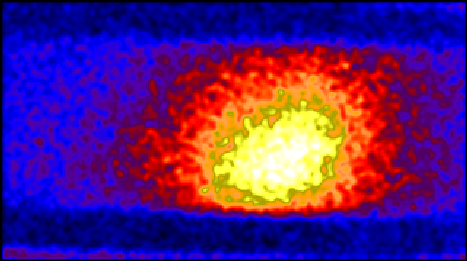Astronomy Picture of the Day
Discover the cosmos!
Each day a different image or photograph of our fascinating universe is
featured, along with a brief explanation written by a professional
astronomer.
March 30, 1996

An Extreme UltraViolet View of the Comet
Credit: M. Mumma
(GSFC)
et al.,
EUVE Support Team,
NASA
Explanation:
As the Sun floods Comet Hyakutake with
ultraviolet light gases in the coma scatter
the radiation and fluoresce making the
comet a bright source in the ultraviolet sky.
The above image made using data from NASA's
Extreme UltraViolet Explorer (EUVE)
satellite, represents the intensity of the comet in this
invisible high energy band in false colour.
The image is about 3/4 of a degree high and 2 degress wide and
offers insights to the composition of this visitor from the
distant solar system that can be obtained from the
highest energy bands of the
ultraviolet spectrum.
The International Ultraviolet Explorer (IUE)
satellite has also
examined ultraviolet light from the comet and
now reports the
detection of many bands of
molecular emission particularly
those due to molecular carbon (C2), carbon monoxide (CO) and
caron dioxide (C02) ions as well as indications of a rapid increase
in the production of water (H20).
Tomorrow's picture: The Latest on Comet Hyakutake
<
Archive
| Index
| Search
| Calendar
| Glossary
| Education
| About APOD
>
Authors & editors:
Robert Nemiroff
(MTU) &
Jerry
Bonnell (USRA)
NASA Technical Rep.:
Jay Norris.
Specific rights apply.
A service of:
LHEA
at
NASA/
GSFC
&:
Michigan Tech. U.
